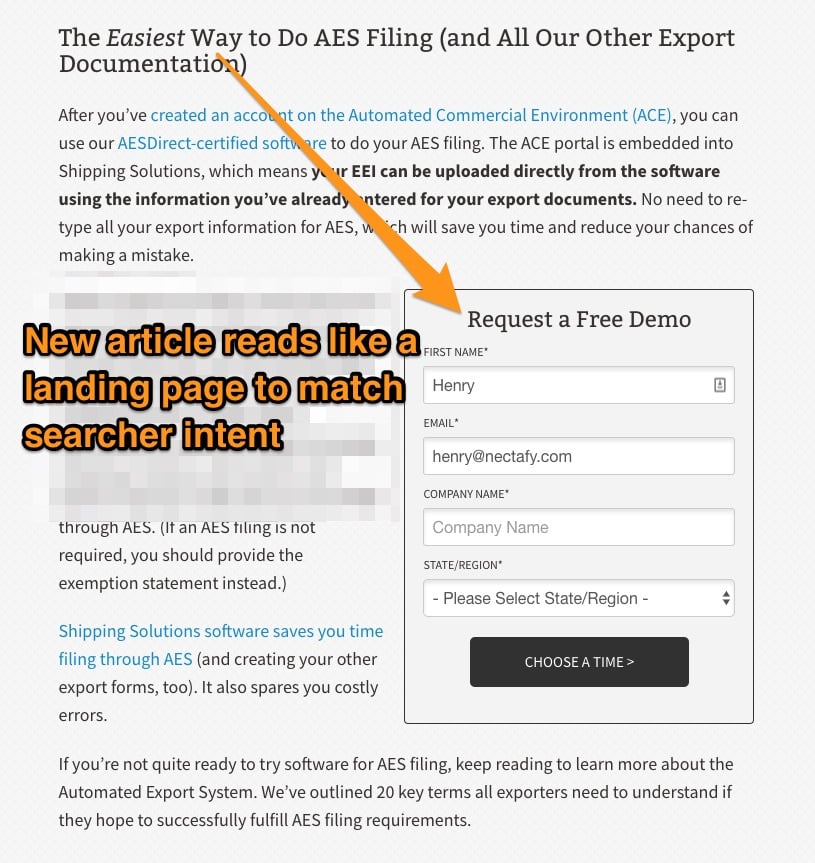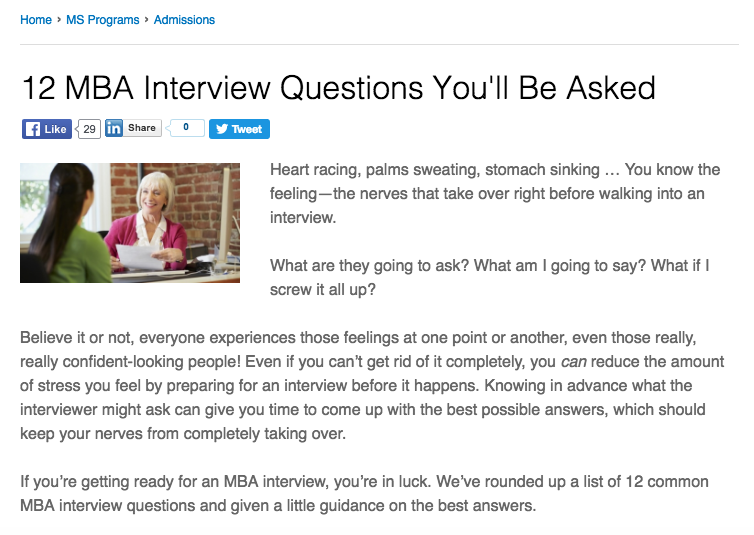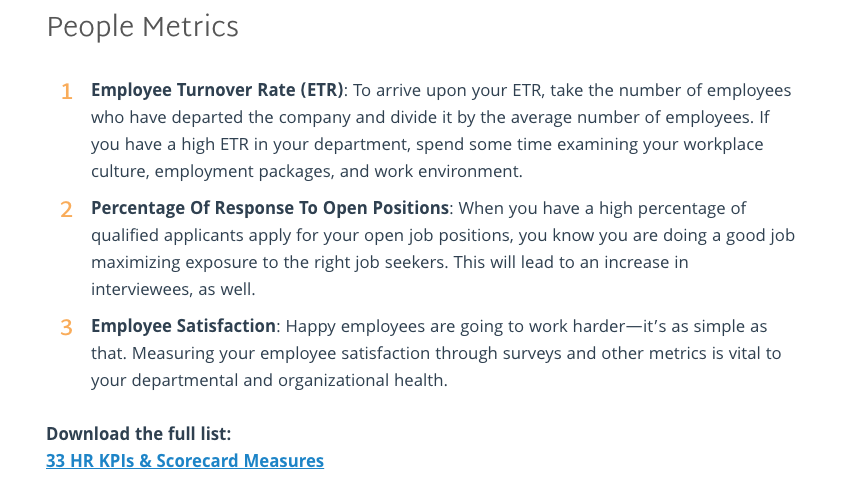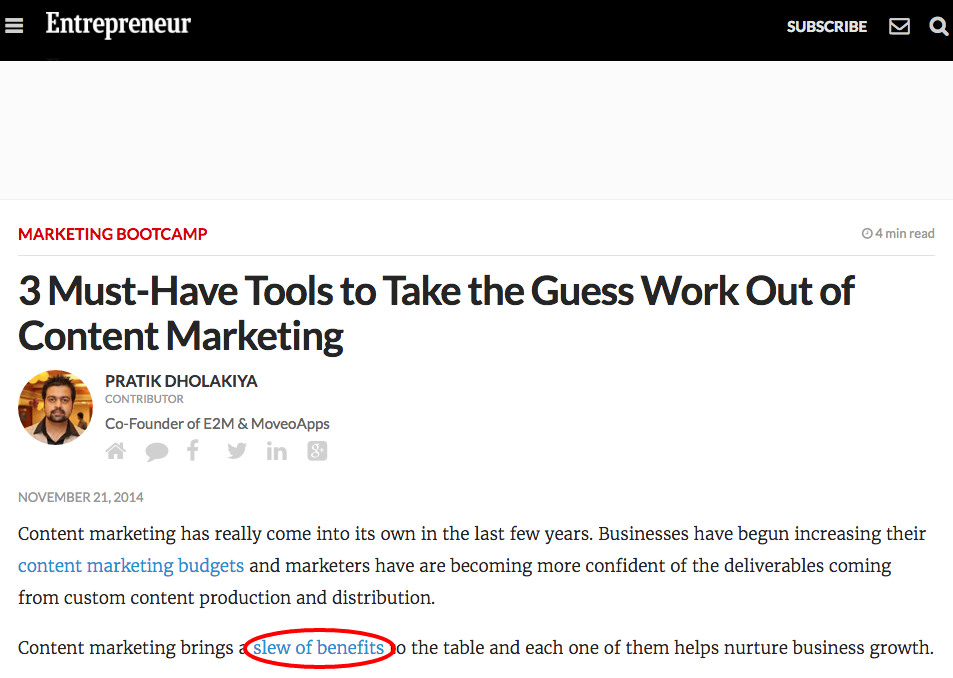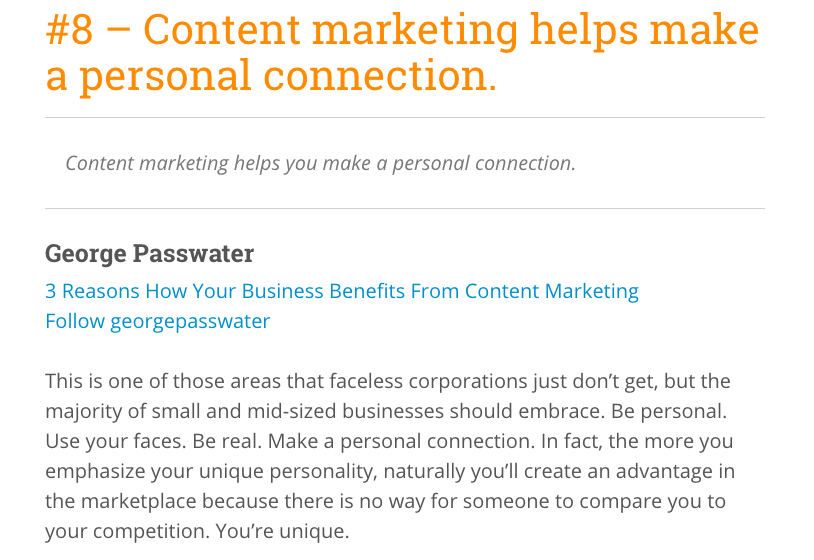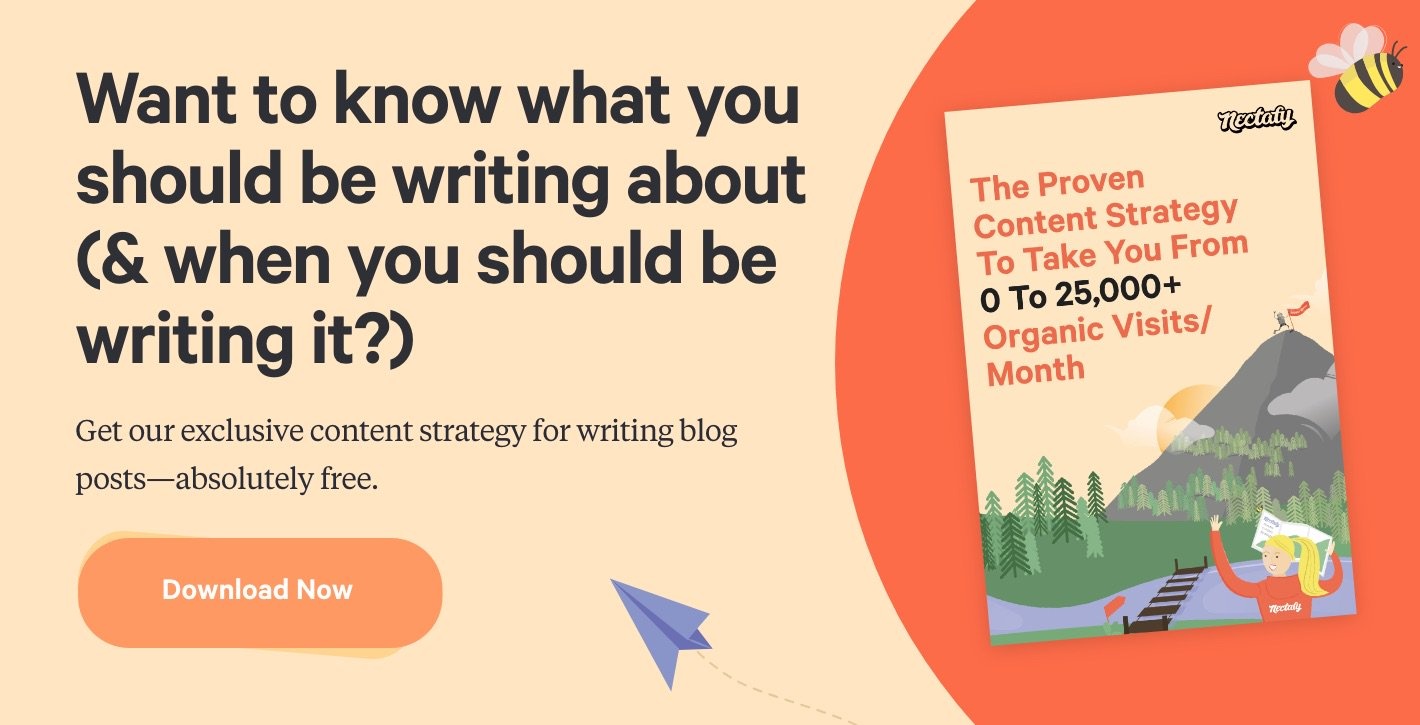13 Inbound Marketing Examples You’ll Want To Try Yourself



What do tight-knit relationships, delicious cookies, and excellent inbound marketing have in common?•
What do tight-knit relationships, delicious cookies, and excellent inbound marketing have in common?
None of them happen by accident. And sometimes, the best way to get inspired to improve one of them is to see what is working for someone else.
Any piece of inbound content that boasts astronomical conversion rates or through-the-roof traffic is very likely the result of methodical planning. If you are looking to give your content a boost, these seven crazy-effective inbound marketing examples may be just what you need.
1. Shipping Solutions’ Bottom-of-funnel Landing Page
Originally titled “20 Terms You Need to Know When Filing through AES,” this article ranked #1 in Google for the term “AES filing.” It had zero free trial requests out of 22,000 all-time page views.
The strategy here was to identify where bottom-of-funnel keywords were ranking with existing top-of-funnel content. (Bottom-of-funnel means anything within a search phrase that indicates the searcher is looking for a solution, not a resource—solutions usually include words like software, tool, company, platform, product, solution.) We then reworked the existing article to better match the bottom-of-funnel content.
The Result
The bottom-of-funnel landing page now gets three free trial requests out of 2,000 page views.
How It Was Done
We rewrote the article as “AES Filing Software by Shipping Solutions (Plus 20 Key Terms),” where it’s currently ranking second in Google for the term "AES filing.” This is a small, incremental win, but if we can do this easily and quickly for multiple keywords, we're moving our client’s sales opportunities in a big way.
How You Can Do It
- If a blog post is ranking for a bottom-of-funnel keyword, then consider adding a bottom-of-funnel landing page at the top of the article. This addition keeps the existing content that’s ranking, but provides a call-to-action that better matches what the persona is searching.
- One caveat: You can expect a slight decrease in visits to pages where you’ve employed this inbound marketing technique because your keyword ranking likely will slip a few spots, but you should find you’ve increased your bottom-of-funnel leads.
2. ClearPoint Article Rewrites
About two years after we started creating content for one of our clients, we noticed a trend—visits to formerly high-performing blog posts had started to drop. But it wasn’t an easy trend to spot. Their new content was doing well, and things looked pretty good from a birds’ eye view. To get a better handle on the problem, we went page-by-page through their blog posts. That’s when we found that, for posts that had previously ranked very well, visits started trending downward after 18-24 months.
To stop this downward trend, we decided to rewrite specific blog posts.
Results
After rewriting these seven existing blogs, our client got 26,929 more visits over a two-month period. That’s a 37% increase in organic website traffic! Here’s a look at the data after a two-month period before and after republishing:
| Blog Post | Re-post date | 2 months prior | 2 months after | Difference | % Difference |
| Blog Post A | 9/26/2017 | 5539 | 7286 | 1747 | 31.54% |
| Blog Post B | 9/19/2017 | 1779 | 4733 | 2954 | 166.05% |
| Blog Post C | 9/12/2017 | 11121 | 19137 | 8016 | 72.08% |
| Blog Post D | 8/3/2017 | 48254 | 56457 | 8203 | 17.00% |
| Blog Post E | 10/10/2017 | 2675 | 5031 | 2356 | 88.07% |
| Blog Post F | 8/21/2017 | 855 | 1554 | 699 | 81.75% |
| Blog Post G | 9/19/2017 | 1779 | 4733 | 2954 | 166.05% |
| Total | 72002 | 98931 | 26929 | 37% |
How We Did It
We did these two things over a two-month period:
- We audited the client’s existing blog posts and noted which older posts were slipping fast. We identified seven previously high performers that needed help.
- We rewrote/revised all seven of them: We wrote new posts targeting new keywords to bring in new growth, and we rewrote old posts so they would stay as close to their peak as long as possible. You can get all the details for this specific client example here.
How You Can Do It
You can find out how to identify which posts need to be rewritten in this article. And if you are blogging (whether you’re getting no results or even some nice results), I strongly recommend reading the post below that fits your scenario:
- The Proven Content Strategy If You Have <1000 Organic Visits/Month
- The Proven Content Strategy If You Have 1,000 to 25,000 Organic Visits/Month
- The Proven Content Strategy If You Have 25,000+ Organic Visits/Month
3. BalancedBack’s™ Comparison Post
Some comparison topics are difficult to rank for individually, but by putting the topics together in one post, you provide an answer to a question your persona is looking for and give yourself an excellent chance to rank for a keyword.
Our client, BalancedBack™, offers a new total disc replacement procedure that serves as an alternative to spinal fusion.
The Result
- Comparison article posted June 2017.
- Originally targeted five keywords that totaled 300 searches per month.
- 1,239 views and 5 sales opportunities in the most recent month.
- Ranking on page one for 62 different keywords.

Anytime you can do a “this vs. that” comparison for a topic, you have excellent fodder for a high-ranking blog post. Why? Lots of people use Google to compare things in their decision-making process.
Comparison posts work because they’re useful to personas; there’s searchable volume for keywords; and there’s usually not a lot of competition. We’ve done comparison posts for our clients and they’ve ranked on page one almost every time.
How It Was Done & How You Can Do It
- Visit Keyword Planner.
- Click on “Multiply keyword lists to get new keywords.”
- Enter all your brainstormed terms on one side with a “vs” after each, and enter all the same terms on the other side without the “vs”.
- Click “Get search volume” rather than “Get forecasts.”
You can get the steps in detail in our article, A Non-Competitive SEO Strategy: Comparison Keywords.
4. Nectafy’s Combination Post
If you have blog posts ranking on page one of Google, you’ll probably also have posts ranking on pages two through five. The bad news? You’re not getting anyone to your site unless the content is ranking on page one. The good news? Ranking so high (even if it’s not on page one) means you’re showing progress—already ranking 12th (for example) out of a million results—so use that to your advantage! Instead of writing a new article on a new topic, mine your posts to see what’s ranking between pages two and five, and combine these existing posts to potentially boost your rankings.
We call this creating a “combination” post, and it’s exactly what it sounds like: Combining your existing blog posts on a common subject into one large post. If your current blog has several smaller posts with a common subject (e.g. top keywords in an industry), you may find in your analysis that two (or more) blog posts on the same keywords are both ranking on page two of Google. We used this tactic with our own blog posts.
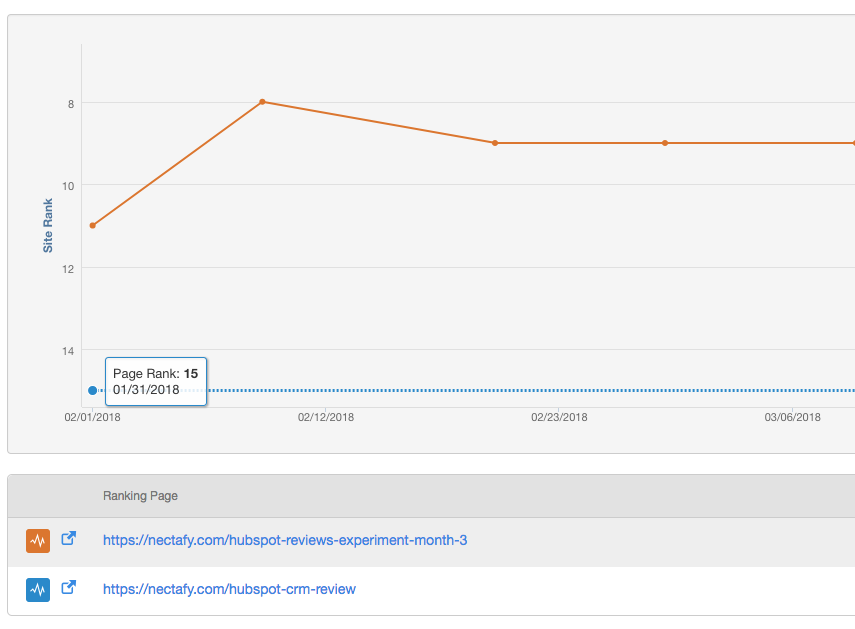
The Result
For example, the image above shows we had two pages ranking for the same keyword (ranking at 11 and 15 respectively). When one dropped out (where you see the dotted line), the other jumped to 8. One article on page one is better than two on the middle of page two.
Why does this work? If you have two blog posts on a similar topic both ranking on page two, the posts are cannibalizing one another: They are both doing OK, but not well enough to get to page one, where the majority of your audience will find the post—and you.
How It Was Done & How You Can Do It
Instead of allowing this cannibalization to continue, find out which of your articles are currently ranking on pages two through five of Google; then, combine these posts into one.
Using Google Search Console
If you’re doing keyword tracking using Google Search Console:
- Go to Search Traffic, then Search Analytics.
- Check the box for “position.”
- Download the list.
- Sort the keywords ranking between spots 11 and 50 (pages two through five).

Using SEMrush
You can also use SEMrush to find out which posts you should combine:
- Go to Organic Research under Competitor Research.
- Enter your domain into the search bar.
- Apply advanced filters to include keywords in positions between 11 and 50.
Use this data to see if multiple articles on a single topic are ranking in that range. After combining the articles, post the combination article on the URL of the article with a higher ranking, and redirect the lower-ranking URL to the higher-ranking one. Ta-da! You will likely end up with the new combination article on page one.
5. BlueSnap’s Phrase Matching Article
The goal of phrase-matching articles is to identify keywords you’re already ranking for, find phrases related to them, and then write about those related keywords to scoop them up.
Google tries hard to understand phrases that are similar to one another, so we identified a group of keywords that were closely related and targeted all of them in this BlueSnap article. We ended up targeting the following keywords:
- ecommerce website examples
- ecommerce sites examples
- examples of good ecommerce sites
- best ecommerce site examples
- good ecommerce website design examples
- sample ecommerce website
The Result
By targeting all these phrase-matched articles, we were able to rank on page one of Google for all six keywords. If we’re going to put forth the effort to write about the first keyword, we should target all related keywords; in this case, that resulted in ranking for six instead of just one.
How It Was Done & How You Can Do It
1. Use phrase match searches.
Use SEMrush or keywordtool.io to find exact matches in keyword search. For example, if you add the highest-level phrases you rank for, like “sales” or “sales tips,” the tool will return any search phrases that include those terms.
Another example: If you have a CRM product and your site ranks for “sales tactics" but not “CRM,” look for phrases related to the term “sales tactics.” Then, devote effort and content each month to dominating those related keywords.
2. Use related or latent semantic indexing (LSI) keywords.
Use a tool like Keywords Everywhere (a Chrome plugin) to find keywords related to ones you already rank for. If you rank for one, you’ll have a much higher chance of ranking for the others.
6. ClearPoint’s KPIs Article
Every persona is interested in key performance indicators (KPIs) for their industry, yet articles on KPIs aren’t very common, thus, they’re not competitive.
The Result
ClearPoint has seen staggering results as a result of this KPI article: It attracts tens of thousands of visits per month, ranks on the first page of Google for 42 KPI-related keywords, and even ranks on the first page for the keyword “KPI” itself!
The page authority (PA) of the website was below 40 (out of 100) at the time we wrote the article. This rating means the site had some authority at that time, but it wasn’t a “powerhouse” that was easily able to rank for any keyword we tried to target. So these are some pretty impressive results.
How It Was Done & How You Can Do It
There are two methods you can use to identify KPI keywords in your industry:
- Method #1: Use Google Keyword Planner.
- Method #2: Use the Google Search hack.
Both methods are detailed in this blog post, so check it out and get started writing these easy, non-competitive posts today!
7. Unique Stories from Nectafy
If your company has unique stories backed by data and targeted for your persona, don’t worry about finding perfect keywords—just write the stories. It may seem a little scary to write without the guide of keyword planning, but we’ve done it at our company and it’s paid off handsomely. One specific example is our article, The Anatomy & ROI Of A One Million-View Blog Post.
The Result
Here are the numbers: We had 1,500 views to this article in the first few months, and then the numbers went down—but that’s OK. Because there’s a bigger story: Writing the article returned $5,000 each month in recurring revenue.
That’s right: We closed a client because of this article. They found and read it, went through our sales process, and ultimately partnered with us—this resulted in a $5,000 per month retainer just because we wrote this story.
How It Was Done & How You Can Do It
Find your unique stories. See if they are stories that would resonate or interest your persona(s). Use data if you can. And then, just tell the story! You judge the success of these types of posts differently than “normal” posts—you’ll have to share, email, rely on social means, etc. to get them in front of the people who will be interested in them, because you can’t rely on keywords to drive organic traffic.
8. Bentley’s “Long-Tail” Article
To preface, a “long-tail keyword” is just a fancy term for a keyword phrase that is highly specific (and is usually three words or longer). In the case of this article, the targeted keyword was “mba interview questions,” which had 2,400 Google searches per month and a low competition index. We decided to take advantage.
The Result
Bentley’s article 12 MBA Interview Questions You’ll Be Asked currently gets thousands of visits per year and ranks #1 on Google for the keyword phrase.
How It Was Done
This article is an example of great inbound marketing for several reasons:
- The article targets the keyword perfectly—the keyword phrase is “mba interview questions” and the headline is “12 MBA Interview Questions You’ll Be Asked.”
- The article fits the persona it’s aimed at—someone applying for an MBA.
- The keyword has a solid amount of searches each month but low competition.
- The keyword is resource-based, which makes it easier to write a helpful article.
Also, this article receives more visits per month than the listed number of searches because long-tail, resource-based keywords nearly always help the article pick up rankings for searches related to the keyword as well. So, the potential for an article targeting a long-tail, resource-based keyword is usually greater than the listed Google search volume.
How You Can Do It
If you want to target a long-tail keyword, you’ll need to master the keyword research process first. This section of our 19,000-word inbound marketing plan (which we’ll discuss next) will walk you through the process for selecting competitive keywords your personas are looking for. When you go to write the article, be sure the keyword is directly targeted in the article and that it is truly helpful for your ideal persona.
9. ClearPoint’s Pillar Page
Pillar pages are very long articles (around 4,000 words) that target bigger keywords in your industry. Pillar pages give you an opportunity to rank for competitive keywords you would not be able to rank for in normal-length or long-form blog posts.
As you may have read about previously, pillar pages are a great way to grow your visits, but for companies that already have 25,000+ organic visits per month, they are also great for two reasons:
- They help you keep making progress with topics you already have authority on.
- They provide support for expanding into new topics. Once you’ve written a reservoir, you can continue to improve your ranking by writing supporting guest posts and regular posts linking within them to the pillar page.
Here’s one example of a client’s successful pillar page:
The Result
- Targeted “strategic planning” keyword searched 22,000 times per month.
- Competitive both in SEO metrics and on page one (Wikipedia, Forbes, and Harvard Business Review are all on page one).
- Now have 80 keywords on page one, including “strategic planning.”
- 3,000+ views per month.
- 60 leads per month.
How We Did It & How You Can Do It
The only way you can compete is to make your pillar page the absolute best resource available on the topic. By doing so, you can get traction for more in-demand keywords and more competitive topics. Pillar pages are not a good short-term strategy because they often take several months to gain traction, but they are a good long-term play if you have the resources to create them and are committed to high quality.
Factors for a successful pillar page include word length, tightly related keywords, and quality. Longer content length is correlated to higher rankings in Google, because the more high-quality, extensive content you can provide, the longer people stay around to read it. Time on site is the second most important factor to Google.
10. ClearPoint’s CTA-Conversion Article
Like the Bentley University article, this ClearPoint article also focuses on a very specific long-tail keyword: “key performance indicator examples.”
The Result
This article gets a phenomenal amount of traffic—roughly 30,000 visits every month.
How It Was Done
When this was originally published, it only had one call-to-action (CTA) at the end of the article. As the traffic began to grow rapidly, we revisited our strategy and added basic, relevant links as CTAs throughout the article. For example, in the image above, you can see that the three “people metrics” are followed by a link to “Download the full list” of 33 HR KPIs and measures.
This action nearly doubled the number of visitors who became leads, taking it from a 1.5% to a 2.5% conversion rate.
With 30,000 visits per month, that means we continue to add 300 new leads to ClearPoint’s database each month—and we were able to do this just by revisiting CTA placement within the article.
How You Can Do It
Here’s something you can do today to capitalize on this method:
- Take a look at your articles that have high traffic but aren’t converting as well as you’d like.
- Examine your CTA—does it directly correlate to the topic you’ve written about? If not, change it.
- Add more value to the article by linking to additional offers throughout the article text (as shown in the example above).
- Track the conversion rate over time; you may be pleasantly surprised with the results!
11. ClearPoint’s Offer Introduction Post
This ClearPoint article doesn’t come near the 30,000 visits the previously mentioned article gets monthly, but it boasts an extremely impressive conversion rate.
The Result
Roughly 1,500 people visit this article each month. One out of every four clicks on the CTA, and one in every 10 becomes a lead. A 10% conversion rate is absolutely huge. (Really, if you're looking at even a 3% conversion rate, you're crushing it.)
How It Was Done
This is a testament to how important it is for your CTA to match the content in your article. The article was written specifically as an introduction to the offer in the CTA. It describes how to create a Balanced Scorecard (a strategic framework) in Excel—and then offers a free template to create a Balanced Scorecard in Excel. It doesn’t get much more closely matched than that!
How You Can Do It
It isn’t always possible for every article you write to line up with your CTAs this well—but you can create introductory posts for any new offers you create. Be sure not to divulge everything your offer discusses; you want to create interest in downloading the offer, not give the whole thing away!
12. Nectafy’s Helpful “Inbound Link” Article
A few years back, Lance wrote a huge article (over 6,500 words!) titled 59 Benefits Of Content Marketing From 50 Expert Marketers. It lives up to its headline and provides a ton of great advice and quotes from big-name marketers.
The Result
This article ended up being linked to by several well-known sites, including an Entrepreneur.com article on must-have tools that take the guesswork out of content marketing. “Inbound links” (as HubSpot calls them)—especially those from authoritative sites like Entrepreneur.com—do great things for the article and overall website authority.
How It Was Done
Simply put, Lance wrote an extremely helpful, all-encompassing article—and Entrepreneur recognized that.
How You Can Do It
There are no shortcuts for creating an article like this.
Throwing together something in hopes that it will attract inbound links from a big-name website is a strategy waiting to fail. But if you write something truly helpful, don’t be surprised if you see some inbound links start to come in!
13. Visual South’s Online Videos
According to HubSpot, 90% of users say product videos are helpful in the decision process—and 80% of users recall a video ad they viewed in the past 30 days. In short, people like videos, and they trust them.
Our client Visual South has been creating video clips to embed in web pages and in blog posts—and we’ve seen some neat outcomes.
The Result
The reason short video clips are such effective inbound marketing tools is because they bridge the gap between online marketing and a sales meeting. They help leads get a sense of how talking to Jack (or working with Visual South) might be, just by watching his mannerisms and getting a sense of his personality. Here’s some data:
Six weeks before launching videos:
- 7.8% conversion rate on landing page
- 102 views
- 8 submissions
- 6 new contacts
Six weeks after launching videos:
- 17.3% conversion rate
- 75 views
- 13 submissions
- 10 new contacts
Using videos, Visual South more than doubled the conversion rate compared to the six weeks prior. While it’s a small sample size, the difference is so huge that we think the improvement is going to hold up over time.
How It Was Done & How You Can Do It
Anyone with a camera and an internet connection can film a video—but if you want your video to attract and convert your personas, you may need to give it some extra time and attention. At a minimum, you’ll want a decent camera with a tripod (to prevent camera shake), great natural lighting or a video lighting kit, and a well-thought-out script.
Put the actual person behind the curtain: who you’ll actually talk to, the link between the site and your sales conversations. When people get there, they know where they are going and they’ve established some trust.
14. Social List Articles
A “social list article” is simply a list your persona would find value in. We call them social list articles because they’re lists that have “sharing appeal” on social media. A list like this may highlight experts, tools, statistics, quotes, links, or books your persona would have an interest in.
The Result
We’ve created social list articles for nearly all of our clients and seen some excellent results. ClearPoint’s article The Top 8 City Managers To Follow On Twitter now has 4,500 all-time visits, and most of those visits are from Twitter and sites referring to it. ClearPoint also got three links from government sites to this article, which is extremely valuable for ranking.
And we don’t just recommend that clients create social list articles—we create them as well! Remember Lance's article, 59 Benefits Of Content Marketing From 50 Expert Marketers, from #12? Since publication, it has received 13,000 all-time views and 27 external links.
Here are some other social posts from around the web for inspiration:
- 38 Digital Marketing Software Tools Top Agencies Recommend
- Remote Work Tools: The Complete List
- The Best Advice for Agencies in 2020: 15 Experts Weigh In
How It Was Done
We’ve found that when we create this kind of content that is extremely useful for a persona, they’re likely to share it via social media for two reasons:
- They’ve been mentioned on the list (as was the case with the ClearPoint “Top 8 City Managers” article) and want to share it with their followers.
- They found enough value in the list to share it with their friends and/or followers who may also be interested (as was the case with the Nectafy “59 Benefits Of Content Marketing” article).
How You Can Do It
The most difficult aspect of creating a social list article is gathering the information you need. After all, your persona is going to find value in this article simply because they don’t have to do the legwork—you’ve done it for them!
Here are a few tips to get you started in your research:
- Help A Reporter Out (HARO): HARO is a platform that allows companies to gather information for articles, while providing thought leaders an opportunity for media coverage. It is often used by journalists, but it holds a great deal of value for inbound marketers.
- Twitter is the main platform for sharing this information—so consider starting your search there. Try searching relevant hashtags that may help you compose your list.
- Ask your clients or customers for their perspective on your list—they may provide you with some industry insight that would otherwise be overlooked.
Have an inbound marketing example that is just as crazy-effective as these?
Tell us in the comment section below or tweet us @nectafy—let’s learn from one another!

